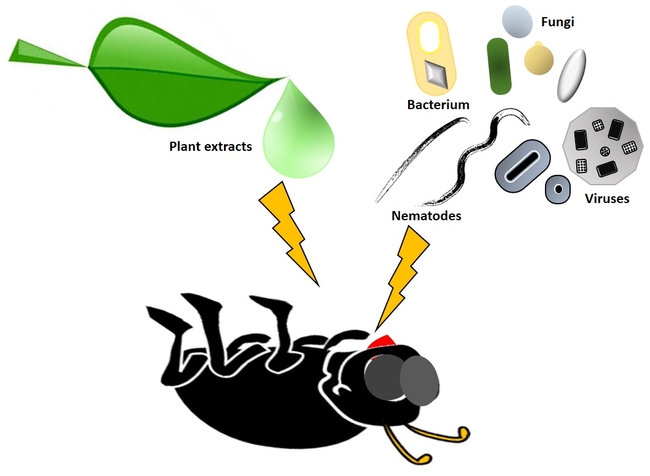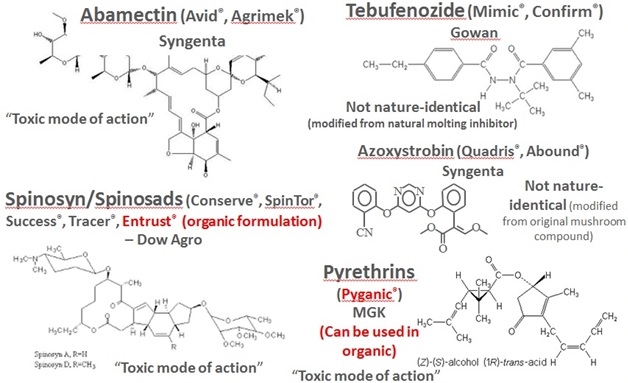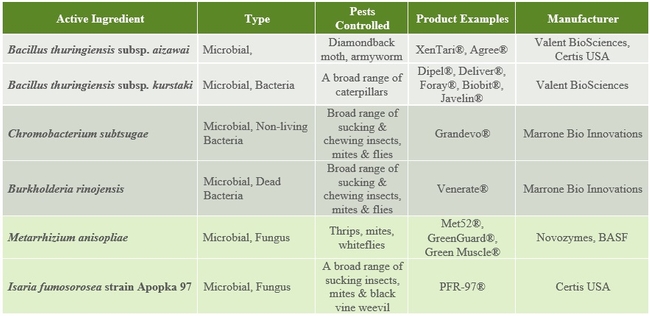Biopesticides are based on naturally occurring microorganisms, plant extracts or other materials and are regulated by the United States Environmental Protection Agency (EPA)'s Biopesticide Division. Biopesticides have been safely used for over 63 years and are generally subjected to reduced regulation compared to conventional chemical pesticides.
Biopesticides can be developed from plant extracts or entomopathogenic microorganisms. Graphic: Surendra Dara
The active ingredient in microbial pesticides consists of a microorganism, such as a bacterium, fungus, nematode, protozoan or virus. While microbials are capable of assisting in the management of many different types of pests, each type of microorganism tends to be relatively specific for a target pest or group of pests. Biochemical pesticides are based on naturally occurring substances, which function by providing pest management through non-toxic mechanisms. Biochemical pesticides may function by disrupting or interfering with mating, such as in the case of insect sex pheromones or various plant extracts which serve as insect attractants used with traps. Conventional pesticides, by contrast, are generally synthetic materials that directly kill or inactivate the pest (Leahy et al., 2014).
Biopesticide development
Typically, samples of microorganisms or infected arthropods are collected from natural environments. Samples are taken to the laboratory and plated on media; thereafter, various colonies form from the collected samples. Individual colonies of interest may be selected, suspended, and examined for pesticidal activity during laboratory bioassays (Taylor, 1988). As part of the laboratory bioassay process, researchers screen candidates against a number of potential targets, which may vary widely, depending upon institutional goals and availability.
A key initial task is identification and characterization of the pesticidal compounds sourced from the plants or microbes collected in natural settings (Strobel and Daisy, 2003). Part of this process involves isolating and eliminating any compounds which have potential human health implications or may negatively impact non-targets organisms (USDA, 2017b). Additionally, analytical assays based on bioactive chemistry are developed to ensure quality control during the manufacturing process (Strobel and Daisy, 2003).
Several steps are involved with product and process development. First, user-friendly formulations are developed in both lab and pilot facilities. Next, manufacturing processes are developed and scaled in arenas including lab, pilot, and manufacturing facilities (Strobel and Daisy, 2003). Thereafter, field studies are conducted and data are gathered for the regulatory submissions which support product registration (USDA, 2017a).
Biopesticide registration process
A special committee has been established within the EPA due to the fact that it is often challenging to determine whether a substance meets the criteria for classification as a biochemical pesticide (Leahy et al., 2014). The Biopesticide Pollution Prevention Division (BPPD) of the EPA is charged with data review required for registration. Requirements for registration include acute studies consisting of oral, inhalation, intravenous, and dermal tests, in addition to eye and skin studies in rodents. A product chemistry review involving a five-batch analysis is also required by BPPD. Microbiology and quality control investigations assure that material is free of human pathogens. Ecological effects, including impact on non-target birds, fish, Daphnia, honeybees, lacewings, ladybeetles, and parasitic wasps is additionally determined. The review process is taken one step further during the endangered species review. Finally, the matter of the Exemption from Tolerance Petition for Food Use is addressed (EPA, 2017). It should be noted that efficacy data are required in addition to the aforementioned topics when attempting to register a new biopesticide in California (CDPR, 2017). There are several examples of successful pesticides which are sourced from natural products and registered as chemical pesticides (Fig. 1).
Fig. 1. Chemical pesticides developed from natural sources. Graphic: Melissa O'Neal
Abamectin is an insecticide/miticide derived from Streptomyces avermitilis, a microorganism found in soil. Its mode of action involves interference with neurotransmission (CDPR, 1993). Tebufenozide is an insect growth disruptor which interferes with insect molting hormones (Smagghe et al., 2012). The spinosyns are a family of chemicals produced by fermentation of Saccharopolyspora bacteria which are toxic due to disruption of neurotransmitters in both target and non-target organisms (Kirst, 2010). Azoxystrobin is a synthetic material derived from phytotoxic compounds which naturally occur in the mushrooms Oudemansiella mucida and Strobilurus tenacellus. Its mode of action is disruption of energetic reactions involving ATP synthesis (AgChemAccess, 2015). Finally, pyrethrins are naturally occurring materials derived from the chrysanthemum (Chrysanthemum cinerariaefolium) flowers and acts as a contact nerve poisons (Extoxnet, 1994).
The following tables 1-5 provide an overview of some of the commercial biopesticides currently registered in the US and other countries for controlling insects, mites, plant pathogenic fungi, and plant parasitic nematodes.
Table 1. Microbial insecticides andacaracides.
Table 2. Plant extract and oil insecticides and acaricides.
Table 3. Microbial fungicides.
Table 4. Non-microbial fungicides.
Table 5. Bionematicides.
References
AgChemAccess. 2015. Azoxystrobin. http://www.agchemaccess.com/Azoxystrobin.
(CDPR). California Department of Pesticide Regulation. 1993. Abamectin Avert Prescription Treatment 310 (Section 3 Registration) Risk Characterization Document. http://www.cdpr.ca.gov/docs/risk/rcd/abamectin.pdf
(CDPR). California Department of Pesticide Regulation. 2017. How to apply for pesticide product registration. http://www.cdpr.ca.gov/docs/registration/instructions.htm
(EPA). U.S. Environmental Protection Agency. 2017. Biopesticides. https://www.epa.gov/pesticides/biopesticides#what
Extoxnet. 1994. Pesticide information profile: Pyrethrins. http://pmep.cce.cornell.edu/profiles/extoxnet/pyrethrins-ziram/pyrethrins-ext.html
Kirst, H.A. 2010. The spinosyn family of insecticides: realizing the potential of natural products research. J Antibiot 63(3): 101-11. doi: 10.1038/ja.2010.5.
Leahy, J., M. Mendelsohn, J. Kough, R. Jones, and N. Berckes. 2014. Biopesticide oversight and registration at the U.S. Environmental Protection Agency. In Biopesticides: State of the Art and Future Opportunities; Coats, et al.; ACS Symposium Series; American Chemical Society: Washington, DC, 2014.
Smagghe, G., L.E. Gomez, and T.S. Dhadialla. 2012. Insect growth disruptors. Adv Ins Phys 43: 1-552.
Strobel, G. and B. Daisy. 2003. Bioprospecting for microbial endophytes and their natural products. Microbiol Mol Bio Rev 67(4): 491-502.
Taylor, J.K. 1988. Quality assurance of chemical measurements. Chelsea, MI: Lewis.
(USDA). United States Department of Agriculture. 2017a. About AMS.
https://www.ams.usda.gov/about-ams/programs-offices/national-organic-program
(USDA). United States Department of Agriculture. 2017b. USDA FY 2016 avoiding harm from invasive species (USDA Do No Harm 2016 Report, Part 2). https://www.invasivespeciesinfo.gov/docs/resources/usdanoharm20170119.docx







